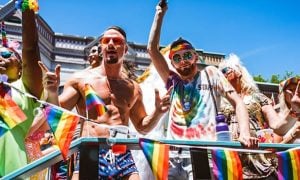Top Surgery For Trans People: A Complete Guide
Top surgery can be a transformative experience for many trans folks, but the research it requires can be overwhelming. So many online resources use confusing, jargon-heavy language, leaving you with more questions than when you started. Luckily, we have you covered – here’s the Gayety plain-English guide to top surgery for trans people.
RELATED: A Brief But Thorough History of the Word “Transgender”
What Is Top Surgery? Gender Affirming Procedures Demystified
Top surgery involves significant alterations to one’s chest size, shape, and appearance, usually as part of a transgender person’s medical transition. This major surgery is usually performed by plastic surgeons with specific gender-affirming surgeries and chest reconstruction training.
That said, there are two main kinds of top surgeries that transgender people usually consider. Namely:
- FtM top surgery: FtM top surgery usually refers to bilateral mastectomy or masculinizing chest reconstruction. This type of chest surgery involves removing the breast tissue for a more flat silhouette.
- MtF top surgery: MtF top surgery refers to procedures designed to increase breast size. This type of top surgery is similar to breast augmentation procedures or chest reconstructive surgery for breast cancer patients. The result? A fuller. silhouette.
Why Do People Get Top Surgery?
If you or someone else in your life is considering getting top surgery, you may be wondering why some people decide to go under the knife. Lucky for you, we’re here to clear up some of the confusion.
Many transgender individuals experience gender dysphoria, which leads them to seek out gender-affirming surgery on top of transitioning socially. The World Professional Association of Transgender Health (WPATH) defines gender dysphoria as “a discomfort or distress about the discrepancy between a person’s gender and their sex assigned at birth.”
For some, this can develop into chest dysphoria, the usual precursor to top surgery.
The bottom line? Some people feel their bodies don’t match their gender identities and undergo surgery to feel more like themselves. However, keep in mind that not all trans folks experience gender dysphoria.
so we can all agree that hunter schafer is a goddess right? right pic.twitter.com/TFZCxQYJtD
— Isa ⧗ (@scarletIore) February 16, 2022
Who Can Get Top Surgery?
Now that we’ve covered the basics of top surgery, you may be wondering who qualifies for trans-specific breast augmentation surgery or chest reconstruction. Thankfully, the answer is quite clear-cut.
Any surgeon who will perform top surgery adheres to the World Professional Association of Transgender Health (WPATH) standards of care criteria. You (or your loved one) will be asked to demonstrate the following:
- Have well-documented gender dysphoria (usually via a mental health provider)
- Able to make a fully-informed decision and give consent to their gender-affirming surgery
- Of legal age and able to make medical choices
- In good physical health, with other medical conditions managed
- Undergo hormone therapy for other gender identity-related objectives
View this post on Instagram
How Much Is Top Surgery?
You may now be asking yourself, “how much does top surgery cost?” Cost is important for many people, especially considering how costly surgery can get, and it’s best to be prepared long before the initial consultation with your surgeon.
While some medical professionals may charge differently depending on their surgical technique, a patient’s health insurance coverage, and any additional surgery needed, we can give you a ballpark figure.
“Female-to-male” procedures can set you back anywhere from $3,000-$10,000, while “male-to-female” procedures can cost between $5,000-$10,000.
However, it’s important to note that these figures may not always be accurate. You may also need to undergo hormone therapy and consult with a mental health professional before going in for surgery, which can increase your overall costs.
Top Surgery For Transgender Men
Otherwise known as a subcutaneous mastectomy, transmasculine top surgery involves removing breast tissue for an overall more masculine chest. Transmasculine patients have quite a few options for their FtM top surgery, so there’s something for every situation. Here’s a primer on transmasculine top surgery and what to expect.
View this post on Instagram
Preparation
Transgender men and non-binary folks preparing for chest reconstruction have to do several things before they’re cleared for surgery.
The path is pretty straightforward and standardized, so you’ll have plenty of information and support as you transition. Also, unlike other types of gender-affirming surgery, transgender men aren’t expected to complete HRT before coming in for transmasculine top surgery.
That said, most patients may find that testosterone therapy can improve postoperative results. That’s because the chest muscle growth associated with increased testosterone can enhance a person’s masculine appearance. Female-to-male patients will also be blood tested before the surgery to ensure their testosterone levels are optimal.
Beyond this, transgender men may also be asked to undergo a mental health evaluation, stop smoking and drinking, or have their meds adjusted before the surgery.
Potential Risks
Understanding potential complications and adverse effects is essential before making any commitments. Like any other surgery, female-to-male or non-binary top surgery comes with its fair share of risks. Here are some of the things you may want to think about when considering top surgery for transgender men:
- Top surgery scars
- Fluid building up underneath the skin
- Blood clots
- Damaged tissue in the nipple area
- An “imbalanced” look in the chest wall or mismatched nipple grafts
View this post on Instagram
Top Surgery Options
One thing to know about top surgery for transgender men is that there are many options based on your preferences. Specifically, your board-certified surgeon will want to know the following things:
- If you want to maintain nipple sensation
- Your feelings on excess skin
- Pre-surgery chest size
If this sounds a little overwhelming, don’t worry – your surgeon should be able to help you make a safe and informed decision.
Double-incision Top Surgery With Nipple Grafts
A double-incision top surgery with nipple grafts is best for those with a large chest or bigger bodies. Here’s what to expect during your double-incision mastectomy:
- After general anesthesia and pre-op prep, your surgeon will remove your nipples and areolas and decrease their overall size.
- Then, your doctor will make long incisions and use liposuction to extract unwanted breast tissue.
- At this phase of your reconstructive surgery, your surgeon will deal with any excess skin, which is less complicated if you have a small chest.
- Your doctor will then suture the incisions shut with a special stitch that prevents skin puckering.
- Lastly, your nipples and areolas will be reattached.
Periareolar Top Surgery
If you have less fat tissue around your chest wall, periareolar top surgery might be the best choice for you. This type of surgery also helps maintain nipple sensation. Here’s what happens when you go under the knife:
- Firstly, your surgeon will make a circular incision around your areola.
- A second, larger, incision around the first one will be made.
- Like other types of transmasculine top surgery, your surgeon will then use liposuction to remove breast tissue.
- Once that’s done, your skin is reattached to your areola. This is achieved by skipping the larger incision, tightening the overall appearance.
Keyhole Top Surgery
Keyhole top surgery is relatively non-invasive compared to other top surgery options. Patients with smaller chests and tighter skin are an excellent match for this procedure. Nipple sensation may also be maintained post-surgery. Here’s how the process usually goes down:
- Your doctor will make a small incision at the bottom of your areola so it’s still partially attached to your skin.
- Liposuction is used to remove excess fat tissue.
- Lastly, your surgeon may resize your nipples for a more masculine appearance. This is only done if necessary or specifically requested.
What To Expect After The Procedure
The first week after your gender identity-affirming surgery can be a little tricky. This is because you’ll be contending with the pain, and your medical team will have you sleep with your chest elevated for the first seven days. On top of this, you’ll be expected to wear a chest binding and draining tubes for several weeks. You’ll also need to avoid lifting anything heavier than 10 pounds while waiting for your postoperative appointment.
A word to the wise: just because you have a nice, new, flat chest doesn’t mean your breast tissue is completely gone. You’ll still need to come in for regular breast cancer screenings to be on the safe side.
Top Surgery For Transgender Women
Appearance can be a large part of gender identity for many trans folks, which is why top surgery can be an excellent way to achieve gender euphoria.
Trans women who decide to get top surgery usually follow a similar path to cisgender women and breast cancer patients looking to augment the appearance of their bust. The procedure is also referred to as feminizing breast surgery, breast augmentation, chest construction, or breast mammoplasty.
Read on for a bit more information on getting the chest of your dreams.
View this post on Instagram
Preparation
Like any other major surgery, trans women and non-binary folks preparing for a chest feminization have to prepare themselves before making an appointment with their board-certified surgeon. Your medical team will walk you through your options for anesthesia, implants, and aftercare. You should also check if your insurance coverage will help you pay for the procedure at this phase.
Beyond this, you’ll go through screening to identify any underlying health conditions. Your surgeon will then make lifestyle and medical recommendations based on your assessment results.
Potential Risks
Despite breast augmentation being a relatively common procedure, there are still a few risks you need to be aware of. Here are some complications patients may encounter throughout their journey:
- Scar tissue that warps or distorts the implant
- Fluid buildup or blood clots at the surgical site
- Chest pain and implant displacement
Also, while not a risk, you’ll probably have to get your implants redone in 10 years or so.
Top Surgery Options
While top surgery for transgender women is procedurally similar to breast augmentation for cisgender women, surgeons have to consider anatomical differences. Factors like chest broadness, muscle thickness, and areola positioning can all impact the final look, but good surgeons can work with all body types to achieve a feminine chest.
That said, your top surgery varies with your intended outcome. Here are some of the most common options for building the breasts that suit you best:
- Saline breast implants: These are filled with saline (saltwater) and are generally soft to the touch. While they tend to be a popping hazard, your body will naturally absorb the saline solution so there’s a lower risk of infection. Saline breast implants also come in a “structured” variant.
- Silicone breast implants: As the name suggests, these implants are made from silicone gel, which can be problematic if they burst inside your chest cavity. Consult with your surgeon regularly to ensure everything is in the right place.
Each type of implant comes in several shapes and sizes to achieve almost any kind of breast shape. We recommend going into your surgeon’s office with reference photos of your ideal breasts so they can help you choose the right combination.
Because you’re usually required to complete HRT beforehand, you may not need large implants to achieve your goal size. However, if HRT didn’t encourage sufficient breast growth, you might need an initial surgery for chest expanders. This expansion process is gradual but allows for the best placement and implantation when your body is ready.
After The Procedure
Bring a trusted friend or family member with you to the operating room to ensure you get home safely. Otherwise, your surgeon might require you to stay in a recovery room for a few days after getting fitted for a compression bra.
Expect some itching, shooting pains, swelling, and bruising as you heal. Avoid strenuous activity and lifting heavy items for a few weeks, too.
View this post on Instagram
Final Thoughts On Top Surgery For Trans People
Top surgery is costly and complicated, but going into it while well-informed can make a massive difference. While the outcome is more than worth it for feelings of gender dysphoria, understanding the costs, risks, procedural options, and postoperative care can make deciding to go under the knife way easier.
We hope our guide helped illuminate a bit of the confusion around top surgery for our trans siblings and supportive allies. Keep reading Gayety for more informational articles and newbie guides to living your best life!
RELATED: ‘Drag Race’ Alum Bosco Comes Out as Trans
View this post on Instagram







